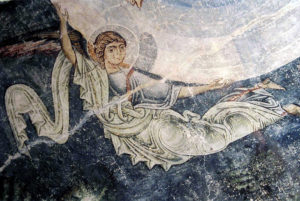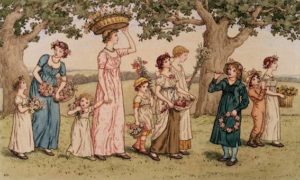
I’m not very good at remembering important things, but I’m really good at remembering odd things, and often with astonishing clarity. Here’s a good example: it’s me, walking into the basement kitchen one afternoon when I was a kid and finding Mom there at the kitchen counter, making supper. I was watching Bugs Bunny cartoons on TV, and by power of suggestion, I wanted a carrot. Mom stopped what she was doing, pulled a carrot from the crisper drawer for me, washed and peeled it, handed it to me, then went back to preparing dinner. I stood there, munching on that carrot, watching Mom at work, when a very important question suddenly popped into my head. So, I asked it: “What are ice cream cones made from?” My mother did not even pause in her work; she just kept going, and she gave me her answer: “Ice cream cones? They’re made from crackers, Johnny.”
Her answer was delivered with so much certainty, I figured Millie Cutrone certainly knew what she was talking about. And so I did not question it and accepted that ice cream cones were made in some process whereby saltines are crushed and pressed into cones, cones that expectantly await my chocolate ice cream. It was years before I re-examined that answer and whether I believed it or not.
I don’t know that it’s my mom’s fault that she raised a gullible kid, and if that’s one of my worser faults, then so be it. She also raised me to write thank you notes for kindnesses bestowed and to wait until everyone was seated at the table for supper and to love holidays and the traditions that come with each, so if you like this Book of Days, you should probably write my mom a thank you note yourself. It was my mom and my grandma and my sister that really instilled in me a fascination with the kitchen and that, in its way, brings me to writing about these things now. I love sharing these things with you, because of all these people who loved sharing them with me.
And here we come to the late spring day each year when we remember and honor our mothers––those we were given, and those we have chosen. And, I’d argue, all the rest of them that helped raise us: the grandmothers and great-grandmothers, sisters and aunts. To all the moms in our lives, no matter where they are: We love you. Happy Mother’s Day.
Photo: That’s me and my mom. It’s a summer evening and I’m going to guess that I’m about 3 years old, so it might just be 1967. I’d like to tell you that it was around that time that I asked about how ice cream cones are made, but I suspect I was considerably older, perhaps 6 or 7 years old, when I fell for the crackers answer.
CURRENT SALE
At the catalog, two sales are in the works: First, it’s the HIGH FIVE SALE: Use discount code HIGH5 at checkout for $5 off your purchase of $35 or more… a sale we’ll run through Father’s Day in June. That’s on everything in the catalog: our own letterpress printed books and broadsides, genuine Shaker herbs and teas, all of our handmade artisan goods for all the seasons. CLICK HERE to shop.
Along with that, there’s the ongoing MASK UP SALE: We are both fully vaccinated now and so grateful for that, but we are following CDC guidelines and remaining masked in any public indoor settings where we don’t know the vaccination status of others. The masks we’re wearing are the embroidered face masks we’ve been selling that are made by an extended family in Chiapas, Mexico. They are beautiful and they are colorful and they are triple layer and buying them helps a REAL family to make ends meet. Plus they’re fun: people are always stopping me to ask me where I got my mask. Originally $16.50, our new price on them is an even $15, and for now we are offering a special: SAVE $10 when you buy any four, plus get FREE domestic shipping. Your total savings when you buy four turns out to be $24.50, our very best deal ever on protective face masks. Can you use the HIGH5 discount code with this? I honestly do not know, and if you do, it may affect your free shipping. Experiment. CLICK HERE to shop face masks, and anything else in our catalog.
Thank you for your support!


